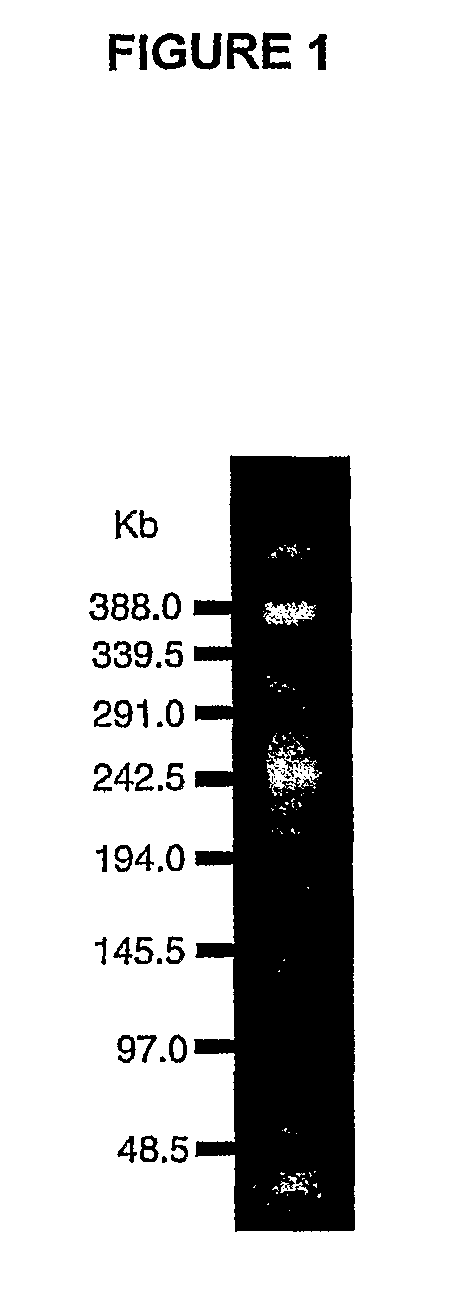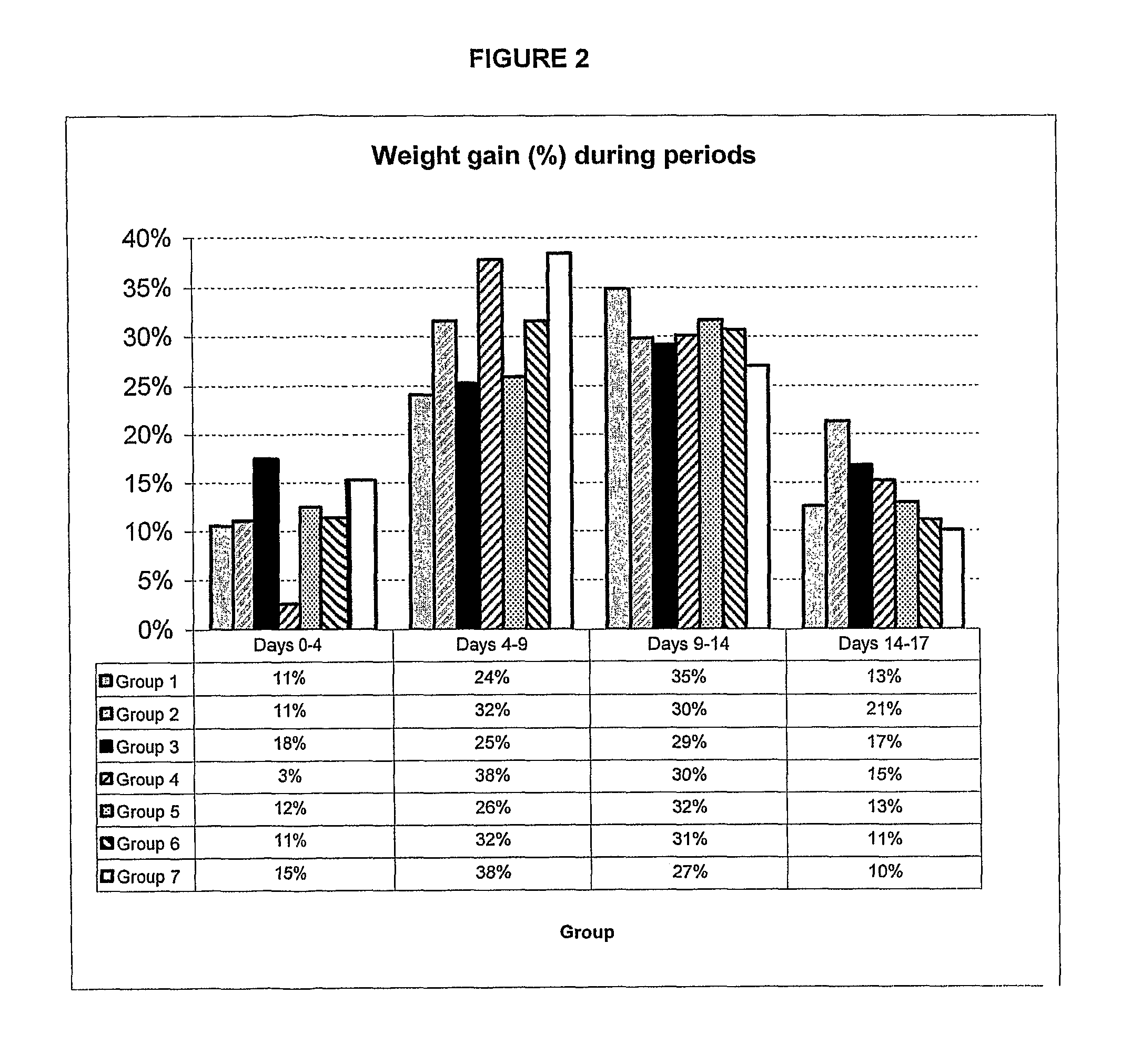Use of live bacteria for growth promotion in animals
a technology of live bacteria and growth promotion, applied in the field of live bacteria for growth promotion in animals, can solve the problems of reduced animal yield, considerable economic loss, and increased production costs of animals, and achieve the effects of avoiding contamination of the soil, promoting growth in animals, and improving feed conversion efficiency
- Summary
- Abstract
- Description
- Claims
- Application Information
AI Technical Summary
Benefits of technology
Problems solved by technology
Method used
Image
Examples
example i
Description of the Escherichia coli strain (coliPROtec strain) and its clones
[0054]According to a preferred feature of the invention, an F4+ non-pathogenic Escherichia coli strain (referred hereinafter as the coliPROtec or the JFF4 strain) is used. The coliPROtec strain was deposited at the International Depositary Authority of Canada on Jan. 21, 2005 and was attributed accession number IDAC 210105-01. The address for the International Depositary Authority of Canada is 1015 Arlington Street, Winnipeg, Canada, R3E 3R2.
1. Origin
[0055]The strain was isolated from feces of a healthy pig at the Escherichia coli Laboratory at the Faculty of veterinary medicine, University of Montreal, Saint-Hyacinthe, Quebec, Canada. Animals were purchased from a local farm located in Monteregie, Quebec, Canada.
2. Stability of the Strain
[0056]The expression of F4 fimbriae, an immunogenic protein, of the coliPROtec strain was stabilized using in vitro passages. Three (3) consecutive 10 L fermentations were...
example ii
Weaned Pigs
Effects of F4+ Non-Pathogenic Escherichia coli Strains, in Oral Form, on the Growth of Pigs
A—Effect of coliPROtec on Weight Gain in Weaned Pigs
1. Escherichia coli Strain:
[0066]The live Escherichia coli F4+ non-pathogenic strain coliPROtec suspended in TSB was orally fed to weaned pigs. This strain is described in Example I.
2. Experiments
2.1 Animals
[0067]Five (5) trials were performed for a total of 45 treated and 45 untreated pigs. These pigs came from different commercial farms.
2.2 Trials
[0068]The trials were conducted at the Faculté de médicine vétérinaire, Université de Montréal, under the following schedule.
2.2.1 Trial Groups
[0069]
GROUP NO. (n)DESCRIPTION1 (45)Untreated2 (45)Treated with coliProtec (with 5E9 / pig)
2.2.2 Trial Schedule
[0070]
DAY NO.DESCRIPTION1Arrival of the 17-day-old weaned pigs.1 To 4Adaptation period5Treatment of the animals with a single dose ofcoliPROtec or TSB only (control group)20 Weighing of the animals;End of the experiment.
2.2.3 Evaluated Para...
example iii
Broiler Chickens
Effects of Live F4+ Non Pathogenic Escherichia coli Strains, in Oral Form, on the Growth of Broiler Chickens
1. Escherichia coli Strains
[0092]The strains used are described in Example I.
2. Experiments
2.1 Animals
[0093]Sixty-three (63) male 1-day-old Cobbs broiler chicks, originating from a clean, conventional chicken farm. After hatching, chicks were transferred into animal facilities.
2.2 Trials
2.2.1 Trial Groups
[0094]At hatching, the chickens were transferred into the animal facilities, containment rooms, Faculté de médecine vétérinaire, Saint-Hyacinthe, Quebec, Canada.
[0095]Laboratory analyses were led at the EcL Laboratory, FMV, Saint-Hyacinthe, Quebec, Canada.
[0096]
GROUP NO. (N)DESCRIPTION1 (10)untreated chickens2 (10)treated with the F4-negative non pathogenicEscherichia coli strain P82-8623 (10)treated with F4+ non pathogenic Escherichiacoli JFF4 strain (coliPROtec)4 (10)treated with the F4+ non pathogenic Escherichiacoli JG1329 strain5 (10)treated with the F4+ n...
PUM
| Property | Measurement | Unit |
|---|---|---|
| weight | aaaaa | aaaaa |
| weight | aaaaa | aaaaa |
| body weight | aaaaa | aaaaa |
Abstract
Description
Claims
Application Information
 Login to View More
Login to View More - R&D
- Intellectual Property
- Life Sciences
- Materials
- Tech Scout
- Unparalleled Data Quality
- Higher Quality Content
- 60% Fewer Hallucinations
Browse by: Latest US Patents, China's latest patents, Technical Efficacy Thesaurus, Application Domain, Technology Topic, Popular Technical Reports.
© 2025 PatSnap. All rights reserved.Legal|Privacy policy|Modern Slavery Act Transparency Statement|Sitemap|About US| Contact US: help@patsnap.com



